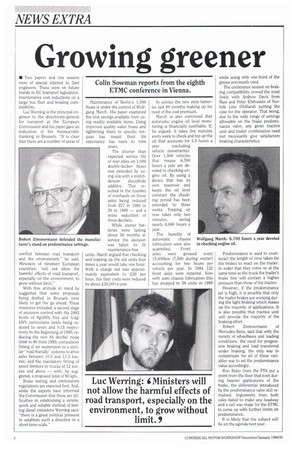Growing greener
Page 82

If you've noticed an error in this article please click here to report it so we can fix it.
Colin Sowman reports from the eighth ETMC conference in Vienna.
• Two papers and one session were of special interest to fleet engineers. These were on future trends in EC transport legislation, maintenance cost reductions on a large bus fleet and braking compatibility.
Luc Werring is the principal engineer to the directorate-general for transport at the European Commission and his paper gave an indication of the bureaucratic thinking in Brussels. "It is clear that th.,:r: a re a :1 „im .1 arc:as r)!
conflict between road transport and the environment," he said. Ministers of nineteen European countries: "will not allow the harmful effects of road transport, especially on the environment, to grow without limit," With this attitude in mind he suggested that some proposals being drafted in Brussels were likely to get the go ahead. These measures included: a second stage of emission control with the 1993 levels of 9g/kWh Nox and 0.4g/ kWh particulates levels being reduced to seven and 0.15 respectively by the beginning of 1995; reducing the new 84 decibel noise limit to 80 from 1995; compulsory fitting of air suspension or a similar 'road friendly" systems to drive axles between 10,5 and 11.5 tonnes; and the mandatory fitting of speed limiters to trucks of 12 tonnes and above — with, he suggested, a proposed limit of 80 kph.
Brake testing and ommissions regulations are expected first. And, while the experts have informed the Commission that there are difficulties in establishing a simple, quick and reliable method of testing diesel emissions Werring says: "there is a great political pressure to establish such a directive in a short time-scale." Maintenance of Berlin's 1,500 buses is under the control of Wolfgang March. His paper examined the cost savings available from using readily available items. Using improved quality water hoses and tightening them to specific torques has meant their life exrectancy has risen to nine years.
The shorter than expected service life of rear axles on 1,000 double-decker buses was extended by using oils with a molyb denum disulphide additive. This restilted in the number of overhauls on those axles being reduced from 227 in 1986 to 39 in 1989 — and a noise reduction of three decibels.
While starter batteries were lasting about 50 months in service the decision was taken to fit maintenance-free units. March argued that checking and topping up the old units four times a year would take one hour. With a charge out rate approximately equivalent to £20 per hour, his fleet costs were reduced by about £30,000 a year. In service the new style batteries last 60 months making up for most of the cost premium.
March is also convinced that automatic engine oil level monitoring is financially justifiable. If, he argued, it takes five minutes every week to check and top up the oil that accounts for 4.5 hours a year (excluding vehicle movements). Over 1,500 vehicles that means 6,700 hours a year are devoted to checking engine oil. By using a device that has its own reservoir and keeps the oil level constant the checking period has been extended to three weeks. Topping up now takes only two minutes, saving nearly 6,000 hours a year.
The benefits of automatic chassis lubrication were also quantified. Front axles were greased every 15,000km (7,500 during winter) accounting for two hours per vehicle per year. In 1984 132 front axles were repaired. Now with auto chassis lubrication this has dropped to 58 units in 1989 while using only one-tnird of the grease previously used.
The conference session on braking compatibility proved the most lively with Andrew Davis from Bass and Peter Elkhuizen of Norfolk Line (Holland) putting the case for the operator. That being, due to the wide range of settings allowable on the brake predominance valve, any given tractive unit and trailer combination need not necessarily give satisfactory braking characteristics.
Predominance is used to counteract the length of time taken for the brakes to react on the trailer. In order that they come on at the same time as the truck the trailer's brake line will contain a higher pressure than those of the tractor.
However, if the predominance set is high, it is possible that only the trailer brakes are working during the light braking which makes up the majority of applications. It is also possible that tractive unit will provide the majority of the braking effort.
Robert Zimmermann of Mercedes-Benz, said that with the variety of wheelbases and loading conditions, the need for progressive braking and load transferral under braking, the only way to compensate for all of these variables was to set the predominance value accordingly.
Ron Rider from the ETA put a point from the floor that even during heavier applications of the brake, the differential introduced by the predominance valve still remained. Arguments from both sides failed to make any headway and a call was made for the ETMC to come up with further limits on predominance.
It is likely that the subject will be on the agenda next year.












































































































